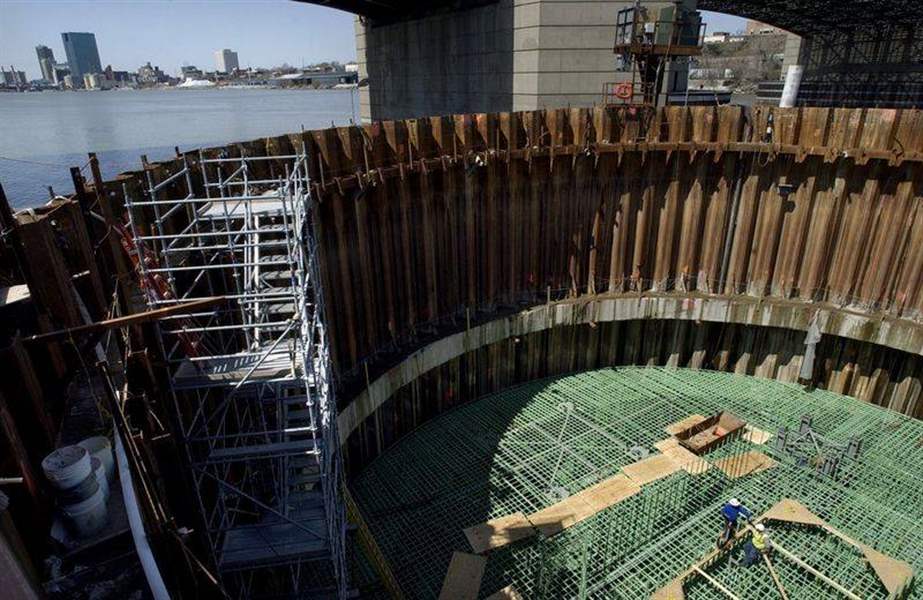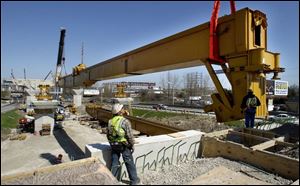
900-ton trusses are heavy lifting
4/24/2003
Iron workers install steel-reinforcing bars in a coffer dam for the new Maumee River Crossing's central pylon. The pouring of concrete is scheduled to begin this morning and take about 36 hours.

Two cranes, working in tandem, hoist into place one of the southbound `underbridge' beams of the new I-280 bridge.
Occasionally barking instructions into a walkie-talkie and switching positions for different views, Tim Mavis kept close watch as men and machines maneuvered 44,000 pounds of steel into place at the Maumee River Crossing construction site late yesterday morning.
The 176-foot long, box-shaped beam - bolted together from five segments and big enough for a ducking man to walk through - is the supporting piece for a huge truss assembly that will be used to move pre-cast concrete bridge segments into position.
Two cranes, working in tandem, hoisted the “underbridge” beam for the southbound structure into place yesterday. Its identical northbound counterpart will be raised today.
During the coming weeks, the truss structures will be assembled from bright yellow parts already gathered at the construction site between the two sides of I-280 in East Toledo.

Iron workers install steel-reinforcing bars in a coffer dam for the new Maumee River Crossing's central pylon. The pouring of concrete is scheduled to begin this morning and take about 36 hours.
Later, during bridge deck construction, the 375-foot truss assemblies will travel along the underbridge beams to move into place for each span's assembly, after the previous span is completed. Once the trusses are positioned, the underbridges are moved along as well, completing a span-by-span cycle.
The trusses, built new for this project and imported from Italy, will be used to carry and position each of several thousand pre-cast deck segments for the bridge. When assembly is finished at the East Toledo end, each truss will be dismantled and then re-assembled in North Toledo.
“Every day, I'll be able to say, `I worked on that, I helped build that,'” said Mr. Mavis, a foreman with Ironworkers Local 55, as he anticipated the day in 2005 when the $220 million, cable-stayed bridge over the Maumee River opens to traffic. “I'll tell my grandkids that.”
At 900 tons each, the two trusses will be nearly twice the weight of a smaller truss workers have used for several months to build the bridge's two elevated interchange ramps to Front Street. Yesterday, that crew positioned the last segment needed to complete the fourth span for the southbound I-280 exit ramp.
Another project milestone will arrive around sunrise this morning, when foundation cement for the bridge's central pylon will begin to be poured.
For 36 consecutive hours, cement mixers will shuttle back and forth along Front, hauling 5,400 cubic yards of cement to the site from a batch plant near Wheeling Street, a mile away, Ohio Department of Transportation spokesman Joe Rutherford said. At 10 cubic yards per truck, the shuttle will require 540 truckloads, or about 15 round-trips an hour.
A latticework of reinforcing steel rods has been laid out inside a cofferdam in the Maumee River in preparation for the massive concrete pour. The steel is arranged in five layers at the bottom of the foundation and three layers at the top, with a gap in between that will be solid concrete - “like a concrete Oreo,” Mr. Rutherford said.
The thousands of epoxy-coated rods are arranged in a designed pattern and tied together by hand - not welded, since they need to be held in place only until the concrete sets around them.
The rod pattern includes an O-shaped array of particularly thick rods to which the central pylon, or tower, will be moored at its base. Also in the foundation is a steel column onto which a construction crane will be temporarily attached.
By year's end, general contractor Fru-Con, Inc., expects the pylon to rise about 250 feet out of the water, well on its way toward its 400-foot finished height.